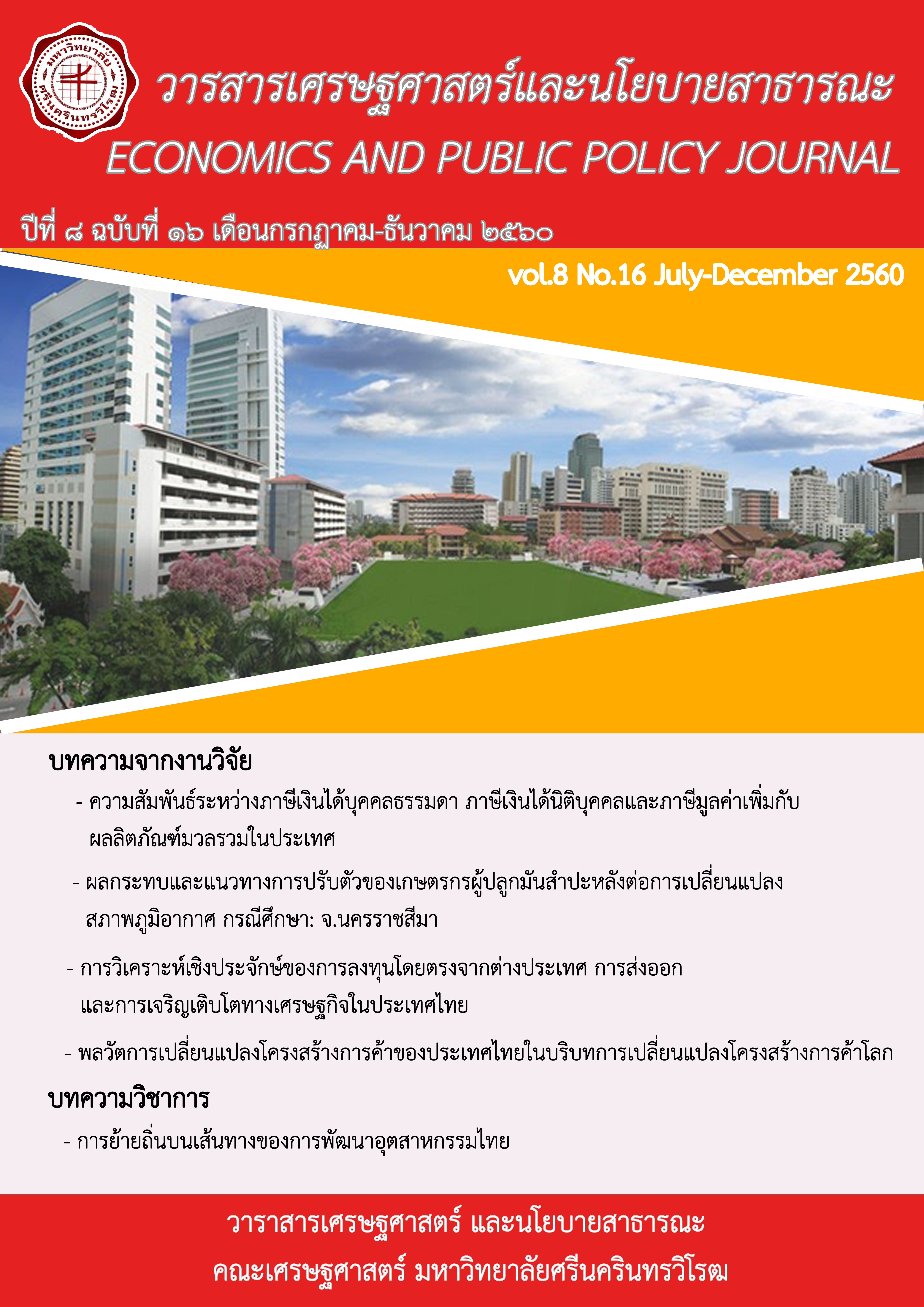การวิเคราะห์เชิงประจักษ์ของการลงทุนโดยตรงจากต่างประเทศ การส่งออก และการเจริญเติบโตทางเศรษฐกิจ ในประเทศไทย An Empirical Analysis of Foreign Direct Investment, Export and Economic Growth in Thailand
Main Article Content
บทคัดย่อ
การวิจัยครั้งนี้มีวัตถุประสงค์เพื่อศึกษาสถานการณ์และนโยบายส่งเสริมการลงทุนและการส่งออกของไทย และเพื่อศึกษาความสัมพันธ์ระหว่างการลงทุนโดยตรงจากต่างประเทศ การส่งออก และการเจริญเติบโตทางเศรษฐกิจของไทย โดยใช้ข้อมูลทุติยภูมิรายไตรมาส ตั้งแต่ไตรมาสที่ 1 พ.ศ. 2536 ถึงไตรมาสที่ 4 พ.ศ. 2558 เพื่อทดสอบความสัมพันธ์เชิงดุลยภาพระยะยาวด้วยวิธีของ Johansen & Juselius การประมาณค่าสมการการเจริญเติบโตทางเศรษฐกิจด้วยแบบจำลองกำลังสองน้อยที่สุด และการทดสอบความสัมพันธ์เชิงเหตุผลด้วยวิธีของ Granger ผลการศึกษาพบความสัมพันธ์เชิงดุลยภาพในระยะยาว อีกทั้งการลงทุนโดยตรงจากต่างประเทศ การส่งออก สต็อกทุน และผลิตภาพแรงงานก่อให้เกิดการเจริญเติบโตทางเศรษฐกิจไทย โดยเฉพาะผลิตภาพแรงงานและสต็อกทุนส่งผลบวกต่อการเจริญเติบโตทางเศรษฐกิจมากที่สุด ประกอบกับการลงทุนโดยตรงจากต่างประเทศและการส่งออกสนับสนุนการเจริญเติบโตทางเศรษฐกิจโดยผ่านช่องทางสต็อกทุนและผลิตภาพแรงงานด้วย
ทั้งนี้ โครงสร้างการลงทุนโดยตรงจากต่างประเทศและการส่งออกของไทยไม่เปลี่ยนแปลงมากนักจากปี พ.ศ. 2536 โดยประเทศผู้ลงทุนหลักยังเป็นกลุ่มประเทศเดิมที่มีการค้าระหว่างประเทศกับไทยสูง การลงทุนโดยตรงส่วนใหญ่อยู่ในสาขาอุตสาหกรรม และสินค้าอุตสาหกรรมเป็นสินค้าส่งออกอันดับหนึ่ง สำหรับนโยบายส่งเสริมการลงทุนและการส่งออกให้ความสำคัญกับการเพิ่มขีดความสามารถในการแข่งขัน โดยสนับสนุนการลงทุนวิจัยและพัฒนา เพื่อให้เกิดการพัฒนาทักษะ เทคโนโลยี และนวัตกรรม สอดคล้องกับผลการศึกษาที่ผลิตภาพแรงงานและสต็อกทุนส่งผลบวกต่อการเจริญเติบโตทางเศรษฐกิจมากที่สุด ทั้งนี้เพราะผลิตภาพแรงงานหรือการพัฒนาทรัพยากรมนุษย์เป็นจุดเริ่มต้นของการวิจัยและพัฒนา ดังนั้นการพัฒนาทรัพยากรมนุษย์เป็นสิ่งที่มีความสำคัญเพื่อให้การลงทุนโดยตรงจากต่างประเทศและการส่งออกสนับสนุนการเจริญเติบโตทางเศรษฐกิจในระยะยาว รวมทั้งการเตรียมความพร้อมของแรงงานสำหรับอุตสาหกรรมเป้าหมาย
Article Details
สงวนลิขสิทธิ์ © 2553 คณะเศรษฐศาสตร์ มหาวิทยาลัยศรีนครินทรวิโรฒ
คณะเศรษฐศาสตร์ มหาวิทยาลัยศรีนครินทรวิโรฒ จัดพิมพ์วารสารเศรษฐศาสตร์และนโยบายสาธารณะ เพื่อเผยแพร่บทความวิชาการทางเศรษฐศาสตร์ นโยบายสารธารณะ และสาขาอื่นๆที่เกี่ยวข้อง ทัศนะและข้อคิดเห็นใดๆ ที่ปรากฏในวารสารเป็นความคิดเห็นส่วนตัวของผู้เขียน โดยบทความที่ได้รับการตอบรับจะถือเป็นลิขสิทธิ์ของคณะเศรษฐศาสตร์ มหาวิทยาลัยศรีนครินทรวิโรฒ
บรรณาธิการ ผู้ช่วยศาสตราจารย์ ดร.ณัฐญา ประไพพานิช
References
ธนาคารแห่งประเทศไทย. (2560). สถิติภาคเศรษฐกิจต่างประเทศของไทย. สืบค้นเมื่อ 15 มกราคม 2560, จาก https://www.bot.or.th/Thai/Statistics/ContactPerson/Pages/default.aspx?pie2=11&pit2=20
สำนักงานคณะกรรมการพัฒนาการเศรษฐกิจและสังคมแห่งชาติ. (2560). สถิติผลิตภัณฑ์มวลรวมภายในประเทศรายไตรมาส. สืบค้น 15 มกราคม 2560, จาก https://www.nesdb.go.th/main.php?filename=qgdp_page
สำนักงานคณะกรรมการพัฒนาการเศรษฐกิจและสังคมแห่งชาติ. (2559). สถิติสต็อกทุนของประเทศไทยฉบับ พ.ศ. 2558. สืบค้น 25 มีนาคม 2559, จาก https://www.nesdb.go.th/main.php?filename=capital_stock
สำนักงานคณะกรรมการพัฒนาการเศรษฐกิจและสังคมแห่งชาติ. (2560). แผนพัฒนาเศรษฐกิจและสังคมแห่งชาติ. สืบค้น 5 พฤษภาคม 2560, จาก https://www.nesdb.go.th/main.php?filename=develop_issue
สำนักงานคณะกรรมการส่งเสริมการลงทุน. (2560). กฎหมาย ระเบียบ และประกาศ. สืบค้น 10 พฤษภาคม 2560, จาก https://www.boi.go.th/newboi/index.php?page=boi_announcements
กรมเจรจาการค้าระหว่างประเทศ. (ม.ป.ป.). FTA Fact Book. สืบค้น 20 กันยายน 2558, จาก https://www.dtn.go.th/images/64/FTAfactbook.pdf
Ali Shah, S.W., Ul Haq, M.A. & Farooq, R.M.A. (2015). Agricultural Export and Economic Growth: A Case Study of Pakistan. Public Policy and Administration Research, 5(8), 88-96.
Ang, J.B. (2009). Foreign Direct Investment and its impact on the Thai economy: the role of financial development. Journal of Economics and Finance, 33, 316-323.
Archanun Kohpaiboon. (2003). Foreign trade regimes and the FDI-growth nexus: A case study of Thailand. The Journal of Development Studies, 40(2), 55-69.
Bagli, S. & Adhikary, M. (2014). FDI inflow and Economic Growth in India an Empirical Analysis. Economic Affairs, 59(1), 23-33.
Barro, R.J. & Sala-i-Martin, X. (1995). Economic Growth. McGraw-Hill, New York.
Bekana, D.M. (2016). Determinants of Foreign Direct Investment in ETHIOPIA; Time Series Evidence from 1991-2013. The Journal of Developing Areas, 5(1), 141-155.
De Mello, LR. Jr. & Fukasaru, K. (2000). Trade and Foreign Direct Investment in Latin America and Southest Asia: Temporal Causality Analysis. Journal of International Development, 12(7), 903-924.
Engle, R.F., & Granger, C.W.J. (1987). Cointegration and Error Correction representation, Estimation and Testing. Econometrica. 55, 251-276.
Hassen, S. & Ochi Anis, O. (2012). Foreign Direct Investment (FDI) and Economic Growth: an approach in terms of cointegration for the case of Tunisis. Journal of Applied Finance & Banking, 2(4),193-207.
Hsia, S.-M. (2014). Foreign Direct Investment, Trade and Economic Growth in Taiwan. Modern Economy, 5, 21-23.
Jajri, I. (2009). Foreign Direct Investment and Economics Growth: Cointegration Techniques. The IUP Journal of Managerial Economics, VII(3&4), 7-18.
Johansen, S., & Juselius, K. (1990). Maximum likelihood estimation and inference on cointegration with applications to the demand for money. Oxford Bulletin of Economics and Statistics, 52, 169-210.
Kaur, M., Yadav, S.S. & Gautam, V. (2013). A bivariate causality link between foreign direct investment and economic growth Evidence from India. Journal of International Trade Law and Policy, 12(1), 68-79.
Nain, Md. Z & Ahmad, W. (2010). Export-led Growth Hypothesis in India: Some Further Evidencds. The IUP Journal of Monetary Economics, VIII(3), 69-82.
Najid, A., Kostelic, K. & Ahmad, A. (2015). Is Export Led- Growth Hypothesis valid in Pakistan? If So. How Relevant is Export to Europe?. Conference Proceeding of the International Scientific Conference (193-213). Juraj Dobrila University of Pura.
N’ Constant, B. Z.S., & Yaoxing, Y. (2010). The Relationship between Foreign Direct Investment, Trade
Openness and Growth in Cote d’Ivoire. International Journal of Business and Management, 5(7), 99-107.
Pesaran, M. H., Shin, Y., & Smith, R. (2001). Bounds testing approaches to the analysis of level relationship. Journal of Applied Economics, 16, 289-326.
Polpat Kotrajaras, Bangorn Tubtimtong & Paitoon Wiboonchutikula. (2011). Does FDI Enhance Economic Growth? New Evidence from East Asia. ASEAN Economic Bulletin, 28(2), 183-202.
Umara, A., Donga, M. & Hayatudeen, S. Z. (2013). An Empirical Investigation into the Effect of Openness of the Economy on the Growth of Output (RGDP) in Nigeria from 1986-2010. Journal of Emerging Trends in Economics and Management Science, 4(6), 554-564.
Roy, S. & Mandal, K. (2012). Empirical Evidence on the Relationship between Foreign Direct Investment and Economic Growth: A Cross-Country Exploration in Asia. Seoul Journal of Economics, 25(4), 413-439.
Saleem A. & Sial, M.H.. (2015). Exports-Growth nexus in Pakistan Cointegration and Causality Analysis. Pakistan Economic and Social Review, 53(1), 17-46.
Shahbaz, M. & Rahman, M.M. (2014). Export, Financial development and Economic Growth in Pakistan. International Journal of Development, 13(2),155-170.
Shihab, R.A., Soufan, T & Khaliq, S. A. (2014). The Causal Relationship between Export and Economic in Jordan. International Journal of Business and Social Science, 5(3), 302-308.
Tasos, S. (2014). Dynamic Relationship between Growth, Foreign Direct Investment and Exports in the US: An Approach with Structural Breaks. The IUP Journal of Applied Economics, xIII(2), 23-37.
Yuan, F., Gouda, G. & Hongyi, L. (2015). The Impact of Financial Development on the Upgrading of China,s Export Technical Sophistication. Int Econ Econ, 12, 257-280.
Zhang, K.H. (2001). Does Foreign Direct Investment Promote Economic Growth? Evidence from East Asia and Latin America. Contemporary Economic Policy, 19(2), 175-185.
UNCTAD. (2017). Foreign Direct Investment. Retrieved March 28, 2017, from https://unctadstat.unctad.org/wds/TableViewer/tableView.aspx?ReportId=96740
UNCTAD. (2017). Economic Trends. Retrieved March 28, 2017, from
https://unctadstat.unctad.org/wds/ReportFolders/reportFolders.aspx

